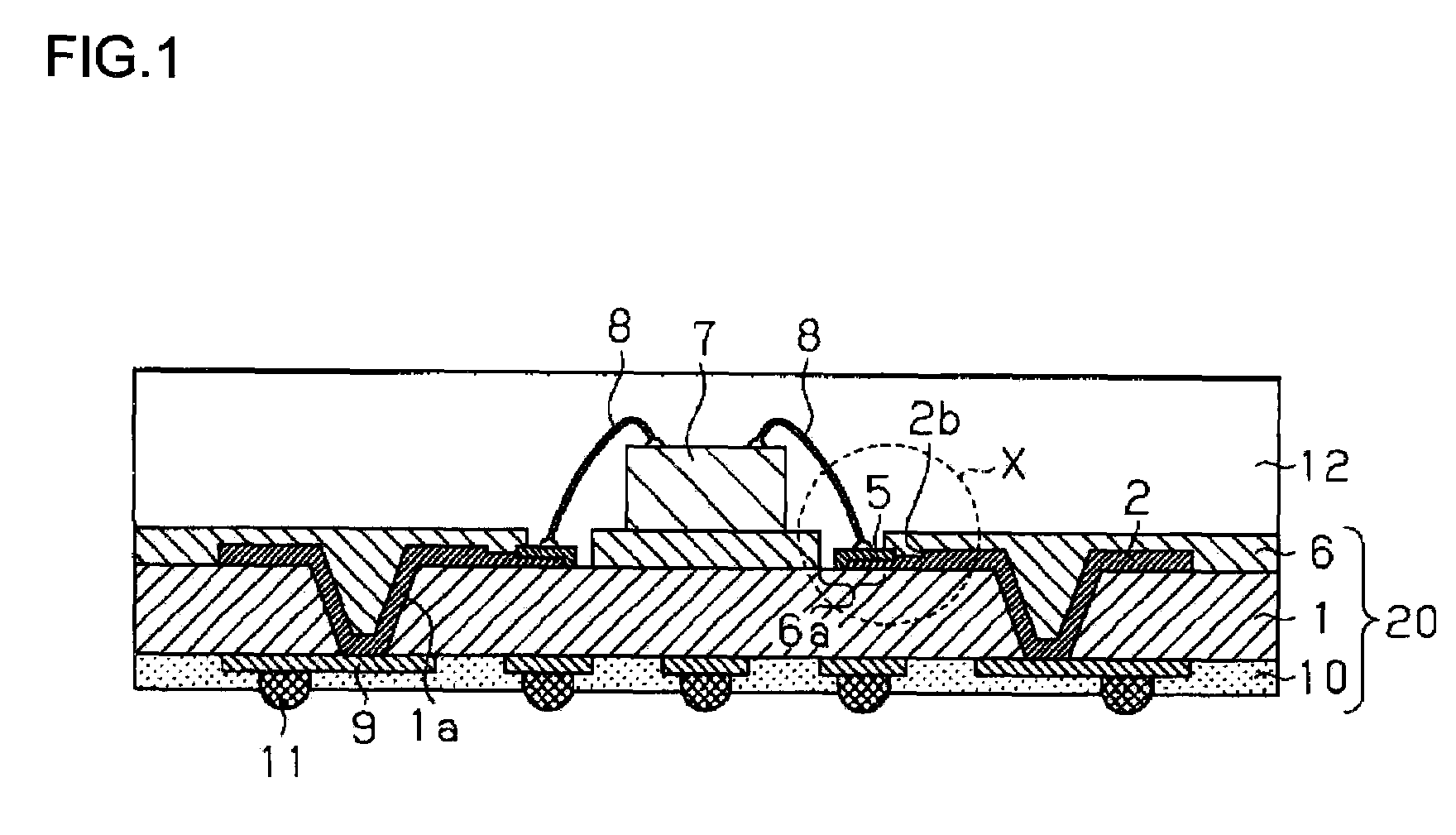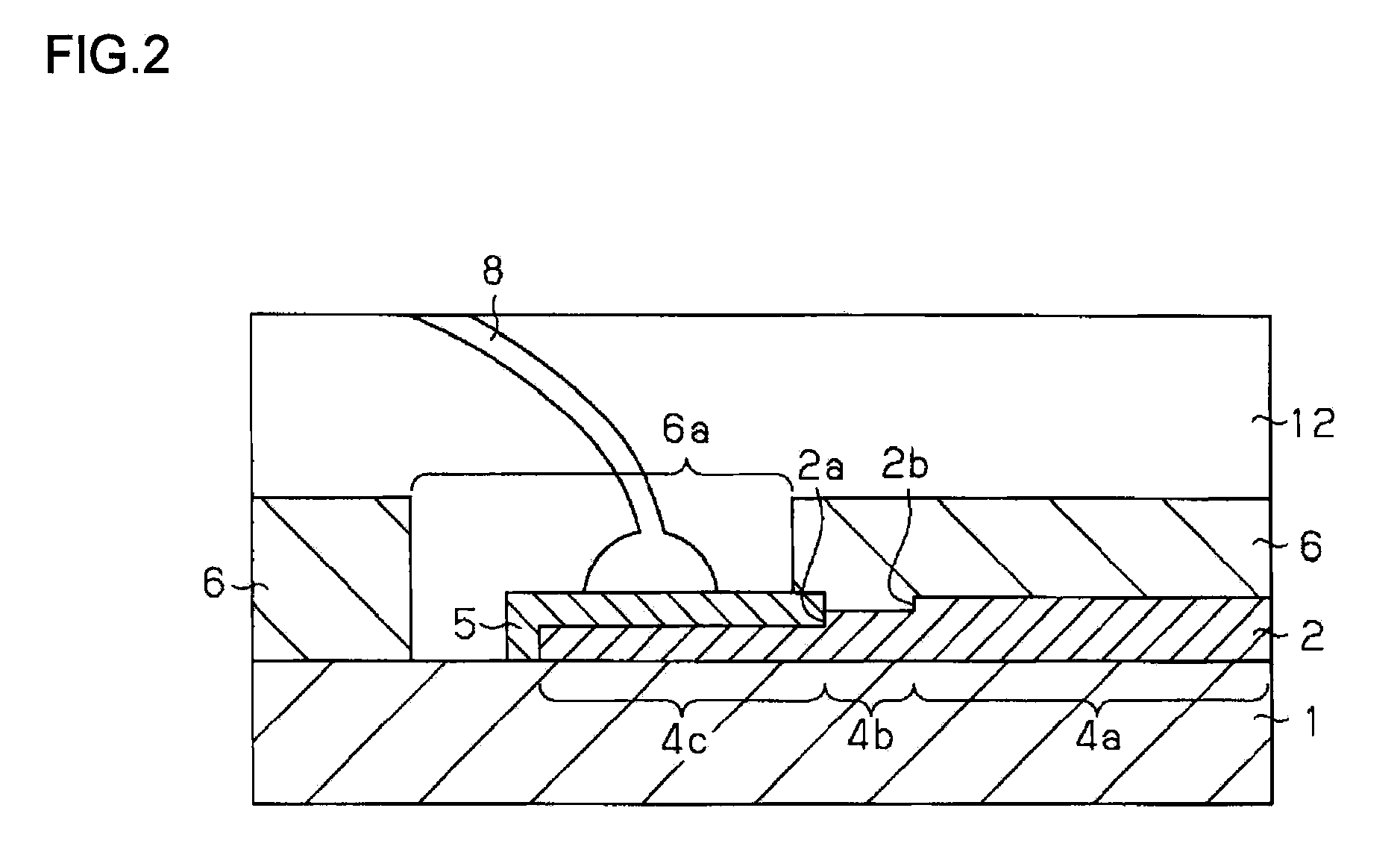Packaging board and manufacturing method therefor, semiconductor module and mobile apparatus
a packaging board and manufacturing method technology, applied in the field of packaging boards, can solve the problems of difficult ion migration between wiring patterns, and achieve the effect of improving the reliability of packaging boards
- Summary
- Abstract
- Description
- Claims
- Application Information
AI Technical Summary
Benefits of technology
Problems solved by technology
Method used
Image
Examples
first embodiment
[0041]FIG. 1 is a schematic cross-sectional view showing a semiconductor module having a pad electrode according to a first embodiment of the present invention. FIG. 2 is an enlarged sectional view of a pad electrode portion (sectional area indicated by X in FIG. 1) of a semiconductor module shown in FIG. 1, and FIG. 3 is a schematic top view of a pad electrode portion of a semiconductor as shown in FIG. 1. Note that FIG. 2 is a cross section taken along the line A-A of FIG. 3.
[0042]A semiconductor module according to the first embodiment has a semiconductor device 7 mounted on the upper face of a packaging board 20 and solder balls 11, as external connection terminals, bonded to the lower face thereof. Provided on upper face of the packaging board 20 is a wiring pattern 2 of copper connected electrically to the semiconductor device 7, and provided on the lower face thereof is a wiring pattern 9 of copper to which external connection terminals are bonded. The wiring pattern 2 and th...
second embodiment
[0063]FIGS. 7A and 7B show cross sections taken along the line B-B of FIG. 3. FIG. 7A is a cross-sectional view of a semiconductor module according to the first embodiment, and FIG. 7B a cross-sectional view thereof according to a second embodiment of the present invention.
[0064]As illustrated in FIG. 7A, a wiring pattern 2 of a semiconductor module according to the first embodiment is a rectangular wiring pattern 2 formed on an insulating substrate 1 and sealed and covered by a solder resist 6. In contrast to this, a wiring pattern 2 of a semiconductor module according to the second embodiment has a skirt-shaped bottom 2c and is further provided with a gap 1b with the insulating substrate 1 along the edges of the skirt-shaped bottom 2c. Otherwise, the structure is the same as one of the first embodiment.
[0065]A semiconductor module, which has the gap 1b with the insulating substrate 1 along the edges of the skirt-shaped bottom 2c of the wiring pattern 2, can be produced by first fo...
third embodiment
[0068]FIG. 8 is a cross-sectional view of a pad electrode portion of a semiconductor module according to a third embodiment of the present invention. The difference with the first embodiment lies in that the surface of the wiring pattern 2 in the boundary region 4b and the wiring region 4a is roughened. Otherwise, the structure is the same as that of the first embodiment.
[0069]A semiconductor like this can be easily produced by roughening the surface of the wiring pattern 2 of copper by a wet process or the like after the process shown in FIG. 6B. For example, a surface treatment using an acidic chemical can create a roughened surface with fine unevenness (fine asperities). Thus the surface of the wiring pattern 2 may be roughened with fine asperities. The arithmetic mean roughness Ra of the wiring pattern after the roughening is about 0.38 μm. The Ra of the surface of the wiring pattern 2 can be measured with a stylus type surface texture measuring instrument. Note that the roughen...
PUM
| Property | Measurement | Unit |
|---|---|---|
| thickness | aaaaa | aaaaa |
| thickness | aaaaa | aaaaa |
| thickness | aaaaa | aaaaa |
Abstract
Description
Claims
Application Information
 Login to View More
Login to View More - R&D
- Intellectual Property
- Life Sciences
- Materials
- Tech Scout
- Unparalleled Data Quality
- Higher Quality Content
- 60% Fewer Hallucinations
Browse by: Latest US Patents, China's latest patents, Technical Efficacy Thesaurus, Application Domain, Technology Topic, Popular Technical Reports.
© 2025 PatSnap. All rights reserved.Legal|Privacy policy|Modern Slavery Act Transparency Statement|Sitemap|About US| Contact US: help@patsnap.com



